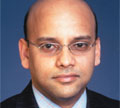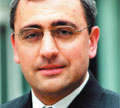
ABS / MBS

|
Weighted votes: 123 Ganesh Rajendra's team has this year leapt into first place for its coverage of asset-backed and mortgage-backed securities, having been on the cusp of the top five bracket for the past two years. Rajendra, head of European securitisation research, joined Deutsche Bank in 2001 from Merrill Lynch. Before that, he was a fixed-income analyst for a Japanese investment bank and an actuarial analyst for an American insurance company. Also in the team are Carole Bernard, Swen Nicolaus and Ivan Pahlson-Moller. Bernard came from JPMorgan in 2002, having worked for a number of years as a securitisation structurer; Nicolaus joined Deutsche Bank research in 1999 as a graduate. The newest team member is Pahlson-Moller, who joined the group earlier this year as a graduate. Over the past year, two analysts have left — notably Markus Herrmann, who joined HSBC as head of ABS research. Each analyst is technically a generalist, able to cover every sector in the European securitisation market, says Rajendra. “While, of course, each analyst tends to focus on sectors of their particular interest, we maintain a discipline where each team member keeps on top of market-wide developments.” Deutsche Bank's securitisation analysis is generally bottom-up: that is, looking at deal-specific trends in any one sector before formulating sector recommendations. Key to the team's research philosophy is to maintain regular dialogue with investors, says Rajendra. In 2003, the Deutsche Bank team recommended overweighting residential mortgage-backed securities (RMBSs), given their credit superiority in weaker European consumer economies. Losses in the RMBS sector remained minimal, supported by benign residential property market conditions – making RMBS the strongest performing sector last year. In the second part of the year, the team recommended commercial mortgage backed securities and collateralised debt obligations. “With evidence of bottoming out in the corporate credit cycle, the outlook for underlying collateral trends appeared more positive,” says Rajendra. The team was bullish on these sectors, which looked relatively cheap – at their widest over the first half of 2003 – with no apparent credit deficiency to show for it. Rajendra says his top specific recommendation last year was in the auto sector: “Corporate concerns vis-a-vis Fiat and Ford led to a significant spread-widening versus sector benchmarks in second half of 2002, and both were at historically wide levels at the beginning of 2003,” he says. “Ford and Fiat auto ABS series tightened significantly by year-end on account of improving corporate creditworthiness,” says Rajendra. |
|
Weighted votes: 106 Asset-backed and mortgage-backed securities and collateralised debt obligations generally offer value over other vanilla credit products, believes Birgit Specht, head of securitisation research at Dresdner Kleinwort Wasserstein. That was certainly the case this year and fortunately for Specht and her team they got it right. Last December Specht said she expected spreads to tighten across the board in all asset classes and all rating levels in 2004 on the back of demand, and reiterated this in the bank's Outlook publications in early January. Most spreads have tightened dramatically since. DrKW also highlighted Dutch, Spanish and Italian residential mortgage-backed securities (RMBSs) as attractive in January, offering more value than UK RMBSs and approved lease asset-backed securities in September – both have performed well since. One of the deals that did not perform well also allowed Specht and team to shine: they published a sell recommendation on September 9 on Scip 2, an Italian securitisation of consumer loans. Spreads blew out shortly afterwards. On the downside, the team did fail to appreciate how strongly CDOs would perform in 2003 and were not sufficiently bullish to take full advantage of that. The year ahead According to Specht, investors should be focusing their attention on quality in securitisations. “Tiering has disappeared, reflecting increased appetite for risk and demand outweighing supply by a good margin,” she says. CDOs are another area to watch, says Specht. “We expect interest in CDOs to increase, as more and more investors are building up expertise, and spreads to tighten on the back of this,” she says. However, Specht notes that some downside risk remains. Higher volatility in the equities markets and a widening of corporate spreads would most probably have a negative effect on CDO spreads. |
|
Weighted votes: 67 Despite adding to a largely stable team, Royal Bank of Scotland's securitisation coverage has taken third place this year, after its first in 2003. Ron Thompson heads Royal Bank of Scotland's financial markets ABS, while Andrew Burton focuses on utilities and structured and securitised bond research. Chris Greener and Steven Behr provide assistance. Hits and misses “We are fortunate to have sophisticated investors as clients, who are demanding and challenging to serve,” says Thompson. “They keep us on our toes. We sensed that a massive technical spread tightening was starting to occur late last year and passed right through the usual ‘buy in December, sell in January' trade.” Thompson says that Enterprise Inns and the residential mortgage-backed security sector – where the bonds tightened in on strength in the housing market and increasing confidence in the sector – were the best calls of the year. Their worst were that market spreads would hold and not tighten in after the Holmes 8 transaction in March this year, and the shift to underweight in housing associations in November, which was “not mirrored by market moves and bond spreads held in”. |
|
Weighted votes: 52 Merrill Lynch did not place in the top five last year for ABS/MBS, so Alexander Batchvarov, managing director of international structured credit research since 1998, can be justly pleased this year. The team has members based in London and Tokyo and covers ABS and MBS as well as new segments such as alternative asset classes, CDOs and CMBS synthetic securitisations. Trends Batchvarov says that during the past 12 months his team has been on the ball regarding the importance of relative value and differentiation in CDOs, the need for tiering realignment in the consumer ABS sector – which subsequently materialised – the relative value of US and European credit cards and the upgrades of German RMBS. He says that investors should be looking out for “different fundamentals of the housing and commercial real-estate markets, which are not reflected in the pricing of the respective securitisations” in 2005. Other trends Batchvarov highlights include swap structures in CMBS transactions in Europe, the effect of interest increases on the securitisation market and the performance of consumer sectors. |
|
Weighted votes: 51 Andrew Dennis joined the research team in 2002 to head coverage of asset-backed and structured finance. Hits and misses “Probably the most successful analysis was on a sterling transaction called Mutual Securitisation, backed by the future emerging surpluses derived from a pool of initially around 500,000 life and pension policies written by NPI,” says Dennis. The bond had suffered a number of downgrades, partially owing to the perceived credit linkage with AMP (which bought NPI shortly after the transaction closed) and partially caused by a sharp deterioration in the value of future emerging surpluses generated by the pool, he says. UBS's analysis focused mainly on the difference between the deal's two tranches and their relative economic seniority. “Although the agencies rated the two tranches on the deal the same, we took the view that there was a significant difference in risk of default and likely recovery,” says Dennis. Both tranches now trade closer to their theoretical values and the rating agencies now acknowledge the difference in risk between the two tranches. |
Only users who have a paid subscription or are part of a corporate subscription are able to print or copy content.
To access these options, along with all other subscription benefits, please contact info@risk.net or view our subscription options here: http://subscriptions.risk.net/subscribe
You are currently unable to print this content. Please contact info@risk.net to find out more.
You are currently unable to copy this content. Please contact info@risk.net to find out more.
Copyright Infopro Digital Limited. All rights reserved.
You may share this content using our article tools. Printing this content is for the sole use of the Authorised User (named subscriber), as outlined in our terms and conditions - https://www.infopro-insight.com/terms-conditions/insight-subscriptions/
If you would like to purchase additional rights please email info@risk.net
Copyright Infopro Digital Limited. All rights reserved.
You may share this content using our article tools. Copying this content is for the sole use of the Authorised User (named subscriber), as outlined in our terms and conditions - https://www.infopro-insight.com/terms-conditions/insight-subscriptions/
If you would like to purchase additional rights please email info@risk.net
More on Structured products
A guide to home equity investments: the untapped real estate asset class
This report covers the investment opportunity in untapped home equity and the growth of HEIs, and outlines why the current macroeconomic environment presents a unique inflection point for credit-oriented investors to invest in HEIs
Podcast: Claudio Albanese on how bad models survive
Darwin’s theory of natural selection could help quants detect flawed models and strategies
Range accruals under spotlight as Taiwan prepares for FRTB
Taiwanese banks review viability of products offering options on long-dated rates
Structured products gain favour among Chinese enterprises
The Chinese government’s flagship national strategy for the advancement of regional connectivity – the Belt and Road Initiative – continues to encourage the outward expansion of Chinese state-owned enterprises (SOEs). Here, Guotai Junan International…
Structured notes – Transforming risk into opportunities
Global markets have experienced a period of extreme volatility in response to acute concerns over the economic impact of the Covid‑19 pandemic. Numerix explores what this means for traders, issuers, risk managers and investors as the structured products…
Structured products – Transforming risk into opportunities
The structured product market is one of the most dynamic and complex of all, offering a multitude of benefits to investors. But increased regulation, intense competition and heightened volatility have become the new normal in financial markets, creating…
Increased adoption and innovation are driving the structured products market
To help better understand the challenges and opportunities a range of firms face when operating in this business, the current trends and future of structured products, and how the digital evolution is impacting the market, Numerix’s Ilja Faerman, senior…
Structured products – The ART of risk transfer
Exploring the risk thrown up by autocallables has created a new family of structured products, offering diversification to investors while allowing their manufacturers room to extend their portfolios, writes Manvir Nijhar, co-head of equities and equity…
 1. Ganesh Rajendra & Team Deutsche Bank
1. Ganesh Rajendra & Team Deutsche Bank  2. Birgit Specht & Team Dresdner Kleinwort Wasserstein
2. Birgit Specht & Team Dresdner Kleinwort Wasserstein  3. Ronald Thompson, Andrew Burton, Steven Behr, Chris Greener Royal Bank of Scotland
3. Ronald Thompson, Andrew Burton, Steven Behr, Chris Greener Royal Bank of Scotland  4. Alexander Batchvarov Merrill Lynch
4. Alexander Batchvarov Merrill Lynch  5. Andrew Dennis UBS
5. Andrew Dennis UBS 






